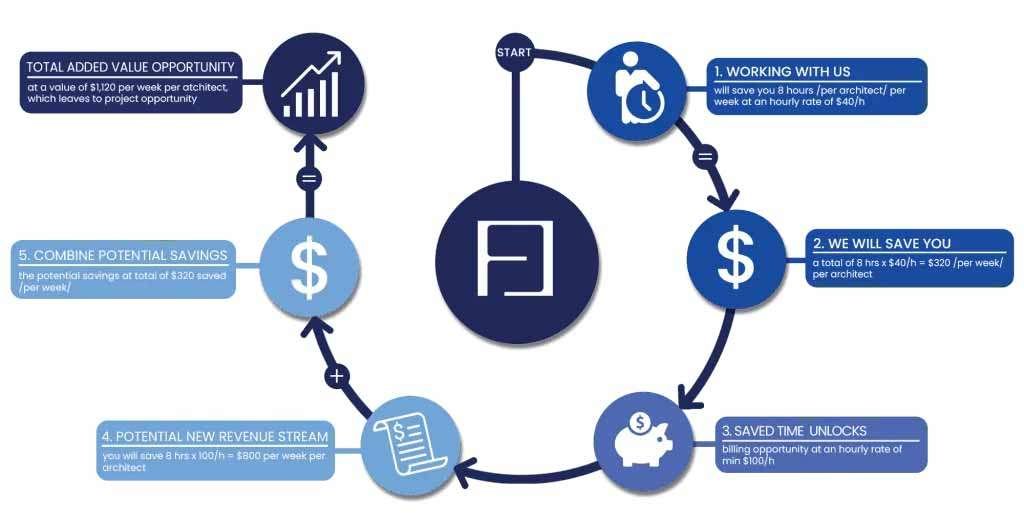AI integration and automation hold the promise of unparalleled efficiency gains. However, for small and medium-sized architectural firms, the prospect of navigating the various tools and solutions available can be overwhelming. The key lies not just in embracing AI, but in strategically selecting tools that cater to the specific needs of your firm. Here, we explore a strategic approach to implementing AI in your small/medium architectural company, with a keen emphasis on how this integration can save both time and money.
1. Researching and Testing the Right AI Integration
The Real Challenge
The overkill of AI and automation tools in the market can be daunting, especially for smaller firms with limited resources. The challenge becomes evident when considering the time investment required to thoroughly research and test these tools. Time, in the business world, equates to money, and the dilemma is clear: how to leverage the benefits of AI without spending an exorbitant amount of time and, consequently, money on research and testing.
2. Understanding Your Unique Needs
Tailoring AI to Save Time and Resources
Before diving into the AI landscape, it’s crucial to identify specific pain points where automation can make a substantial impact. Are repetitive tasks consuming valuable time? Is project management becoming a bottleneck? Understanding your unique needs becomes the cornerstone of a strategic approach, ensuring that AI solutions selected directly address your firm’s pain points, thereby saving precious time and resources.
At Integrated BIM, we empower architectural teams by accelerating modeling processes, enhancing team efficiency, refining workflows, and introducing cost-effective solutions, including advanced AI tools.
Through our practice, we successfully helped many architectural companies to save time and costs.

3. Leveraging Industry Expertise
Time-Saving Insights
Given the time constraints faced by smaller architectural firms, tapping into industry expertise becomes a game-changer. Engaging with forums, attending webinars, and participating in industry events can provide time-saving insights into the tools that have proven effective for firms with similar profiles. Learning from the experiences of others significantly narrows down the options, helping you make informed decisions without investing extensive time in trial and error.
4. Prioritizing User-Friendly Solutions
Accelerating AI Integration
Time is of the essence, and a tool’s effectiveness is often tied to how easily it can be integrated into existing workflows. Prioritizing user-friendly solutions that require minimal training and customization accelerates the AI integration process. This not only saves time but ensures a smoother transition for your team, minimizing downtime and maximizing productivity.
5. Exploring Turnkey Solutions
Efficient Implementation, Cost Savings
For smaller architectural firms, turnkey solutions can be a cost-effective time-saving boon. These comprehensive platforms often bundle AI and automation features tailored for architectural workflows. While it’s essential to ensure these solutions align with your specific needs, the advantage lies in a quicker and more straightforward AI integration process. This efficiency translates to cost savings, allowing your firm to harness the power of AI without breaking the bank.
6. Collaborating with AI Consultants
Cost-Effective Partnership for Integrated BIM AI Excellence
AI integration for small and medium-sized architectural firms, the importance of having a reliable partner cannot be overstated. Collaborating with AI consultants who specialize in the architectural domain is not just about seeking advice; it’s about establishing a cost-effective partnership that streamlines the entire process. A reliable partner becomes an invaluable asset, offering insights tailored to your firm’s needs, guiding you through the decision-making process, and ensuring a seamless integration of AI solutions without unnecessary costs.
Furthermore, as we delve into the realm of AI, it’s essential to promote the concept of Integrated BIM. BIM serves as the backbone for architectural projects, providing a holistic and collaborative approach to design, construction, and operation. A reliable AI consultant can assist in seamlessly integrating AI and automation solutions with your existing BIM workflows, ensuring that the AI business integration is not only efficient but cost-effective.
Partnering with Integrated BIM ensures that your architectural projects benefit from a unified digital representation, where AI seamlessly complements the BIM process. This collaboration facilitates enhanced decision-making, improved project coordination, and a reduction in errors through automated and intelligent processes.
As you navigate the complexities of AI integration, envision your firm not only adopting cutting-edge technology but doing so in a manner that promotes a cost-effective, integrated, and synergistic approach for comprehensive project success. Choose a reliable partner who not only understands your unique needs but champions the seamless integration of BIM, AI, and automation for unmatched architectural efficiency without stretching your budget.






